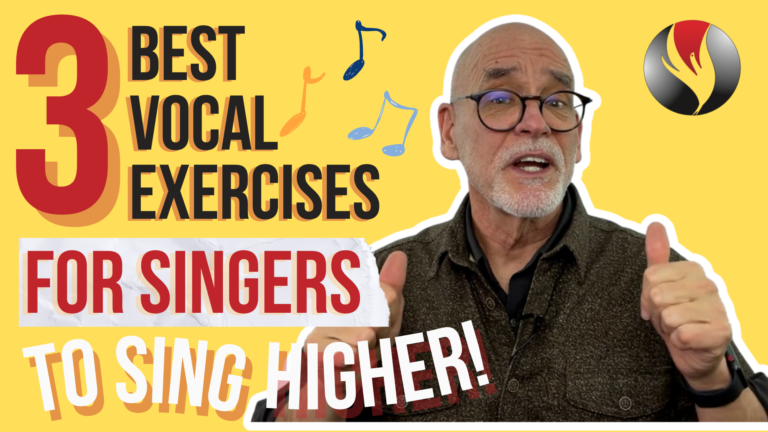How Do I Get My Voice Strong on Stage Without Tightening Up?
All of us can belt our voices and make a big sound. But how do you do it without tightening up and sounding bad? Let me show you!
First everybody is different and what works for you may not work for the next student. Also you might get this in just a few minutes or days. Or it might take months or years.
I’ve told this story before, but Pavarotti told an interviewer that it took him 10 years to get the F4 (F above middle C) to a condition of “elegant” that he wanted. 10 years.
So this might help you by this evening or within the next 10 years.
Get My Voice Strong
Step 1. Release your voice. That means that you disengage the extrinsic neck muscles from the vocal cords. In other words, you don’t use the extrinsic muscles to increase volume and power in your voice.
Use this exercise to disengage the external neck muscles. [Demo] After you get down to the bottom with the “goo” go back up to the top again.
Step 2. Get more depth in the vocal cords by using the word “go” instead of “goo”. Use it with an Octave Repeat scale beginning at the top of the vocal bridge. Ab4 for men or C#5 for women and go down and back up 4 half-steps. Now I’ll demonstrate it in the women’s register. [Demo] Then return back to the top when you finish.
Step 3. Repeat exactly the same exercise with “mum” and sustain it with balanced and consistent air flow. [Demo]
Step 4. Rules. In each instance, you must not begin to reach. That sounds like this. [Demo] If you start reaching, the vowel changes by spreading open. Often the volume gets too loud. You physically push your chin and larynx upward as you reach for the notes. You drive too much air flow. You need less air not more. Do it medium to medium soft.
Step 5. Increase the loudness when you’re able to without violating any of the rules in Step 4 as you do the exercises. This is evidence you have a balance between the air flow and the vocal cords, the vowels are not spreading or splatting, and the larynx is staying down at your speech level. [Demo]
When I do it right, the vocal cords are resisting just enough air to get louder without getting too tight or squeezed. If I loose balance and my cords resist too much air, it feels like I’m closing or grabbing my vocal cords too hard, everything gets too tight and muscled up. I lose release and too often I start reaching (extrinsic neck muscles push the larynx higher) in an effort to make it more powerful. [Demo]
That makes it worse as everything tightens. Then I squeeze the vocal cords tighter and my pitch gets bad and my song suffers.
Step 6. Expect it, don’t direct it. If you over-manage the process, everything tightens up. Go back to release with the “goo”, “go” and “mum’s”. Then sustain it with balanced and consistent airflow always looking for the sense and feeling of release and relax. Try to crescendo while balancing the air and vocal cords. As you do this with release, gently press into the feeling of release. Press into the feeling of letting go. For me it’s 1.) let go first and 2.) then press in immediately after letting go. [Demo]
If feels like you are pressing into the resonance, not the vocal cords. Pressing into resonance feels like I’m getting an extra boost of sound…with some added overtones and often a bright ring-ping in my voice. That’s the feeling you want to experience everywhere from chest to head and back. [Demo]
To me, pressing into the resonance is like pressing onto an elastic surface. There seems to be some give to it. It’s not like pressing onto a hard cement or wooden surface with no give or elasticity.
This is real and reproducible. It’s also possible to lose it if you are trying to direct it or manage or force it. [Demo]
Like a lot of things in art, the harder you try, the more elusive it becomes. Take a break. Listen to a recording of yourself. Relax. Focus on doing everything easier and less loud. It may happen accidentally. Be ready for it.
This isn’t the only way to power. There are other and different ways. This one worked for me. Maybe it will work for you.
Know Your Vocal Type
Knowing your vocal type and doing the exercises for your vocal type will eventually lead to a balanced voice and this kind of power.
Do you know your vocal type? I’m not talking about whether you’re soprano, alto, tenor or bass. Your vocal type is what you tend to do when you sing through the first bridge of your voice.
Go to PowerToSing.com and take the vocal test, the PowerTest. Take the quiz and discover your vocal type. Visit the Knowledge Center and learn about your vocal type. Download the free exercises for your vocal type and start improving your voice immediately.
I’m Chuck Gilmore with Power To Sing. You can sing higher with beauty, confidence and power.
I’ll see you inside the next video.









Responses
Thank you!! You gave me that advice ( the things you explain in the video) a few weeks ago. I’m sure that’s a good and helpful exercise for me. 🙂